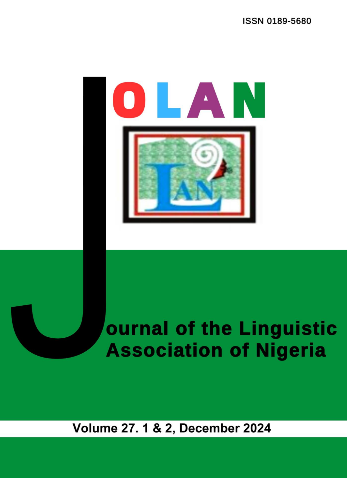Sound Symbolism in Igbo: A Magnus Approach
Keywords:
Sound Symbolism, Iconism, Clustering, OnomatopoeiaAbstract
Sound symbolism is the idea that the vocal sound or phonemes carry meaning in and of themselves. We do not know the similarities or dissimilarities between some languages in some aspects of sound symbolism (specifically, Igbo and English)? This study looks at Igbo sound symbolism using the three approaches of Magnus (Onomatopoeia, Iconism and Cluster). The model was first proposed by Wilhelm von Humboldt. The findings of this paper show that sounds do not become words until a meaning has been put into them, and this meaning represents the thought of a people. Words with meaning are suitable to be conveyed symbolically in sound. Igbo Consonants do not have a tone in Igbo apart from “n” and “m” which are the only letters that can be written with accent marks. Consonants, is to make a sound in speech produced by a stoppage or partial stoppage of the breath; a speech sound that is not a vowel. Igbo is a kwa language of the Benue-Congo subfamily of the Volta-Congo and Atlantic-Congo branches of the Niger-Congo language.
References
Atkinson, Quentin; “Phonemic Diversity Supports a Serial Founder Effect Model of Language Expansion from Africa”, Science, 15 April 2011: p. 346-349
Bolinger, D. (1965) Forms of English: Accent, Morpheme, Order, Hokuou Publishing Company. Tokyo.
Dofs, E. (2008). Onomatopoeia and iconicity (A comparative study of English and Swedish animal sounds). MA Thesis, Karstads University.
Falk, J.S. (1978). Linguistics and language a survey of basic concepts and implications. NY: John Wiley and Sons Publications. Hinton, L., J. Nichols and J. J. Ohala (eds), 1994. Sound Symbolism, Cambridge: Cambridge University Press.
Jakobson. R., Waugh. L. (1979).The sound shape of language, Harvester Press, Sussex.
Jerspersen, O. (1933). Symbolic value of vowel in linguistics, selected papers in English, French and German. Copen hag: Levin and Munksgard Publications.
Magnus, Magaret (2010). Gods of the word: Archetype in the consonants. Createspace ISBN 978-1-4538-2444-3.
Magnus, Magaret (2013). A History of Sound Symbolism. The Oxford Handbook of the History of Linguistics, ed. by Keith Allan. Oxford University Press.
Malkiel, Y. (1994) ‘Regular sound development, phonosymbolic Orchestration, disambiguation of homonyms’ in L. Hinton, J. Nichols, J. J. Ohala (eds) sound symbolism, Cambridge University Press. Cambridge.
Nordberg, B. (1986) ‘The use of onomatopoeia the conventional style of adolescents,’ FUMS rapport nr 132, Uppsala.
Ward, Ida C. (1936). An Introduction to the Ibo Language. Cambridge: W. Heffer and sons, Ltd.
Wescott, R. (1975) ‘Allolinguistics: Exploring the peripheries of speech; in P. Reich (ed), The second LACUS forum, The Hornbeam Press, Columbia, South Carolina, 497-513.
Wescott, R. (1978) ‘Lexical polygenesis: Words as resultants of multiple linguistic pressures’ in semantics and lexicology.
Wescott, R. (1980) Sound and sense: Linguistic essays on phonosemic subjects. Edward Sapir Monograph Series in Language, Culture, and Cognition, 8. Jupiter Press: Lake Bluff; IL.
Yule, G. (1996). The study of language. 3rd (ed). Cambridge University Publications.














